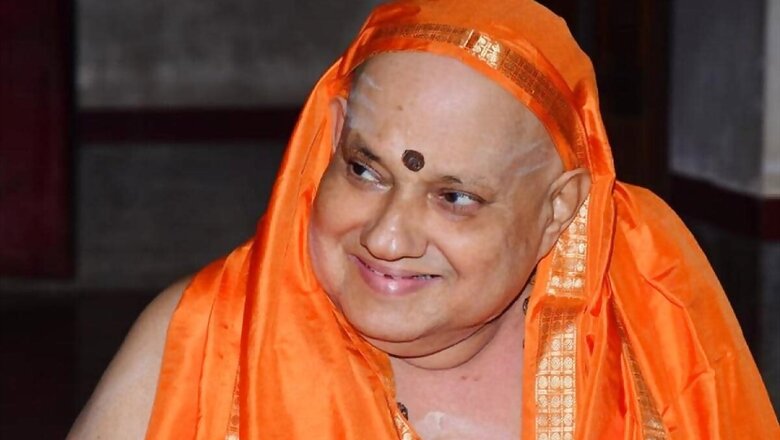
views
Swami Kesavananda Bharati, Head of Edneer Mutt at Kerala’s Kasaragod, passed away on Sunday. The demise of the prominent spiritual leader was mourned by different sections of people. From Prime Minister Narendra Modi to Vice President M Venkaiah Naidu condoled the death of the seer. However, most of the tributes paid to the spiritual leader were underlined by the discussion of the most famous case of Indian constitutional history named after Swami Kesavananda Bharati.
According to famous British jurist and historian Granville Austin, eleven days before Swami Kesavananda Bharti took charge of the Mutt in 1970, he challenged the Kerala government’s attempt under the two-state land reform acts to impose restrictions on the management of church property.
Austin writes in his magnum opus ‘Working a Democratic Constitution’ that a local lawyer wrote to JB Dadachanji, the famous Supreme Court lawyer, who in turn shared the letter with famous jurist NA Palkhivala who agreed to take the case as he felt that the case could lead to important Supreme Court judgments.
Dadachanji and Palkhivala convinced Swami Kesavananda Bharti into fighting the case under Article 29 of the Constitution, concerning the right to manage the religiously-owned property without government interference.
As pointed out by Austin, the grander issues of Parliaments’ power to amend the Constitution arose as court proceedings evolved. The hearing of the case lasted for more than seventy days, making it the longest heard case in India’s constitutional history, decided by 13 judges – the largest bench ever to sit in the Supreme Court to date.
Kesavananda Bharati’s petition also resulted in a judgment that made it nearly impossible for any future government to amend the Constitution in a manner that it takes away its democratic essence and its highest regard for the fundamental rights of the citizens.
It is important to understand that Article 368 empowers Parliament to amend the Constitution without any exception whatever: this was what second Chief Justice of India M Patanjali Sastri ruled in 1952, which was an introduction to the never-ending ‘supremacy’ battle between judiciary and executive. However, 15 years later, in another landmark judgment commonly known as ‘Golaknath’ case, the Supreme Court reversed its earlier judgment.
The constitution bench headed by Chief Justice Koka Subba Rao held that Parliament does not have unfettered and unlimited power to amend and Parliament could not curtail any of the Fundamental Rights in the Constitution.
However, a decade later, it was in ‘Kesavananda Bharati’ case that the Supreme Court held that while Parliament can amend the fundamental right to an extent that is required in “public interest” but at the same time “freedom of the individual needs to be preserved for all times to come and that it could not be amended out of existence”.
In the 703-page judgment with a thin majority of 7:6, the apex court held that Parliament could amend any part of the Constitution so long as it did not alter or amend “the basic structure or essential features of the Constitution.”
Supreme Court in its judgment on April 24, 1973 said, “The basic structure of the Constitution is inviolable, and cannot be amended by Parliament”.
The Court held that any part of the Constitution is permissible only to the extent that the basic structure of the Constitution does not adversely get affected,
Justice HR Khanna had remarked in the judgment, “The power of amendment…does not include the power to abrogate the Constitution nor does it include the power to alter the basic structure or framework of the Constitution.”
The importance of basic structure doctrine can be gauged from what India’s one of the most respected judges VR Krishna Iyer had said about it, “While infallibility is no attribute of a Constitution, its fundamental character and basic structure cannot be overlooked. Otherwise, the power to amend may include the power to repeal. This is a reductioadabsurdem. By a stroke of judicial creativity, the amendatory provision of Article 368 was justly handcuffed in Kesavananda Bharati.
The fallout of judgment was grave. The judgment did not go well with the Indira Gandhi-led government at the Centre and it decided to supersede three judges — JM Shelat, AN Grover and KS Hegde — who were in line to be appointed Chief Justice of India (CJI) after Justice Sikri. Instead, it appointed Justice AN Ray, who had dissented against the majority verdict, as the next CJI.
While the judiciary and senior-most judges had to suffer at the hands of the executive because of their judgment, the fact remains that if they would not have formulated the basic structure doctrine, India would have surely degenerated into a totalitarian State. Along with that, the Constitution would have lost its supremacy.
Eminent jurist HM Seervai in his magnum opus “Constitution of India,” says that the basic structure doctrine preserved the Indian democracy from the onslaught of the totalitarian tendencies that were hellbent at subverting the Constitutional supremacy.














Comments
0 comment